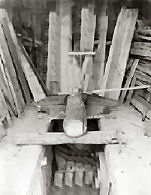

|
The definition of Village carpentry as it was practiced in Victorian times was wider than ours was, and covered practically all the woodworking done except wheelwright's work. Their raw materials were elm and oak felled on local farms with their own saws and axes, and dragged back to their yard by ox or horse. Although the woodworkers of a bygone age may have started with the rawest of materials, the articles they produced would stand wear and weather for many long years. They were frequently clever wood turners, and be it the making of a box for a wheel, the handle of a chisel, or the leg of a table or chair, the workmanship was always first class.
The trunks from the farms would lie in the wood yard until the time came for them to be sawn into planks using the sawpit. For this, one person would stand on the top of the framework fixed above the pit, with the trunk to be sawn placed on end and held there by "iron dogs". He would take hold of the handle of the pit saw at the top, whilst his assistant stood in the sawpit with the moveable handle of the saw in his hands. They would begin sawing early in the morning, and, apart from a few short breaks, and an hour at dinnertime, they would continue sawing until 6 o'clock. It was hard and sweaty, but by the end of the day, there was a small pile of finished planks and a pit partly full of sweet smelling sawdust. After lying for some weeks on drying racks in the workshop, there was enough sawn timber stored and ready to for use in the construction of carts, butts, wheelbarrows, gates, doors, forms, troughs, windows, rough furniture and even coffins. Using the crosscut saw, suitable lengths of the best trunks were cut for use in making wheel boxes. The workshop would have a long carpenter's bench, on which some of their tools rested, the rest either would be hanging on the wall, or locked in a tool cupboard, and in front of the window a lathe. This would be driven by a hand-turned wheel so that, when any turning had to be done both carpenters were engaged, one to keep the lathe working and the other to operate on the wood. There might also be a smaller bench for use in the making of a wheel. Watching the construction of a cart would have been a fascinating experience. With the exception of the lathe, which was hand driven, all the rest of the tools used were hand held. After carefully selecting the timber for use in making the shafts and framework, it would be sawn to size, before being cleaned and planed, using a variety of planes. Bars and spokes for the side of the cart were fashioned and smoothed with the drawknife and spoke shave, then round mortise holes were bored in the framework with old-fashioned drills. Finally, with the axle blocks fitted, and the spokes mortised in place, the cart frame was completed. The next stage was to make the wheels, and this was no easy task. The box of the wheel was first fashioned by placing the selected piece of tree trunk in the lathe. While one man operated the wheel of the lathe, the other plied the chisel, and soon the box began to take shape. When finished it was smooth and perfectly shaped. The hole for the axle was then bored and mortise joints chiselled out to hold the spokes, previously cut, smoothed, and tenoned at each end. The felloes cut and shaped from a piece of rough wood using the adze and a drawknife, and smoothed down using a spokeshave, and finally mortised to hold the spokes. After the addition of dowels and dowel holes, the spokes, previously fitted to the box, would be fitted to the felloes and the rim made firm. The final stage was to take the wheels to the blacksmith's forge for banding. The banding of the wheels took place outside the smithy upon a large round iron plate let into the ground. Placing the wheel on the middle of the plate, the iron tyre, almost red hot, was brought from the forge and placed in position. Hammered into place with sure blows, and then cooled with water. The contracted metal soon fitted tightly and was as firm as a rock. Finally, the axle casings were fixed. When both wheels were completed, they were fixed on the well-greased axle and the rest of the ironwork was bolted on to the shafts. After receiving the coats of paint in grey and red the cart was ready for its work on the farm. Such vehicles are now manufactured in a few days, but are far inferior to the work of those old Craftsmen. Previous Last Edited 03/07/2006 Copyright © 2000-2006 Witheridge Unless otherwise indicated on the page in question, the photographic images reproduced on this site belong to the Witheridge Archives, and, as such may not be reproduced for commercial purposes without written permission. However, you are welcome to use any of the photographs belonging to the archive for personal and/or non-commercial use. Any material shown as not being owned by the archive may not be reproduced in any form without first receiving written permission from the owner of the material in question. |


